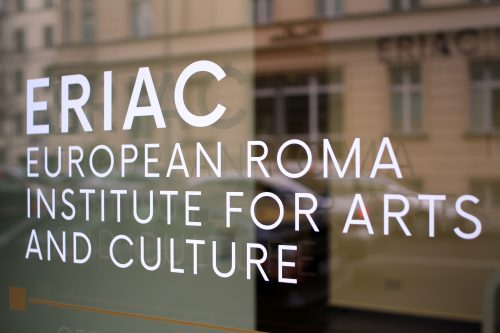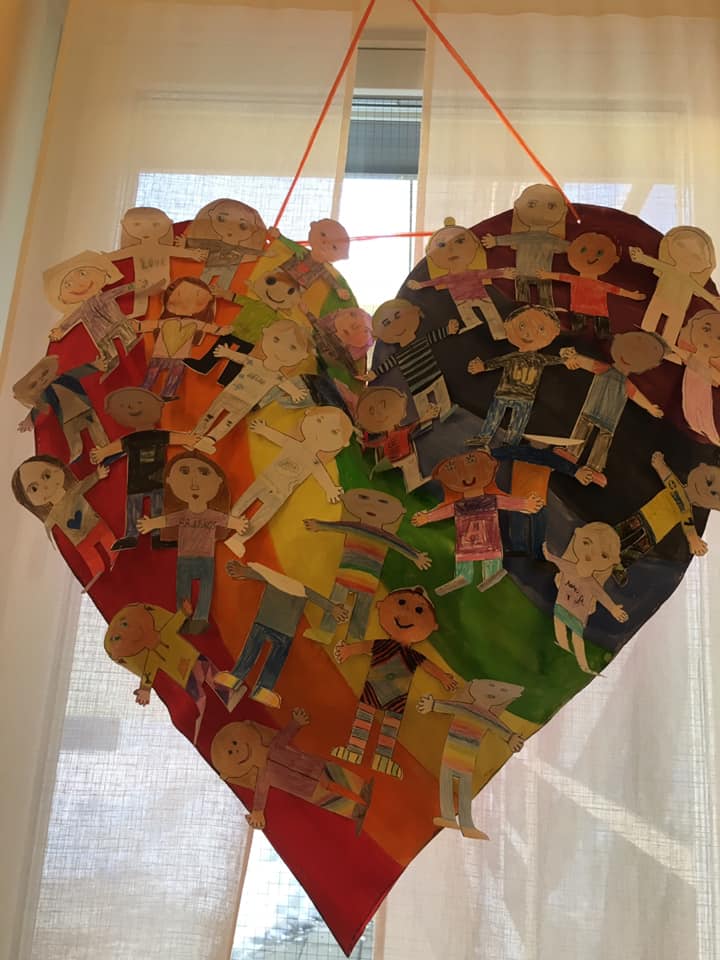
| ERIAC exists to increase the self-esteem of Roma and to decrease negative prejudice of the majority population towards the Roma by means of arts, culture, history, and media. ___________________________________________________________________________________ Källa: eriac.org DIKKO finns på Facebook, Twitter, LinkedIn och Instagram |
| ERIAC Exhibition Opening: Berlin Tales Berlin Tales Emanuel Barica, Luna De Rosa, Mihaela Drăgan, Nihad Nino Pušija, Mersud Selman, Alfred Ullrich, David Weiss 15 December, 2023 – 5 April, 2024Exhibition opening: 14 December 2023, 6.00 – 9.00 pm |
 |
| Berlin has consistently played a crucial role in the cultural and social life of the Roma diaspora and, at the same time, Roma had also made a significant impact on the history of the German capital. However, limited initiatives have addressed the intertwined cultural history of Roma and Berlin. The Berlin Tales exhibition unveils the cultural history of Berlin – a narrative that remains largely unknown, concealed, and suppressed yet simultaneously boasts a beautifully rich genealogy. The exhibition showcases key moments and significant contributions made by Roma to Berlin, and influencing German and European culture since the 1970s to the present day. The Berlin Tales exhibition, along with its associated events including concerts, performances, and discussions, illustrates the enduring and substantial cultural, social, and political presence of Roma in Berlin — both as artists and as an audience. The narrative reveals a potent counterculture that collaborates with other peripheries, aiming to challenge racist representations and combat stereotypical, homogenized depictions of minorities prevalent in mainstream media and society at large. The display also highlights the boundless creativity of contemporary artists, performers, and musicians of Roma origin. All contributing artists, while of diverse nationalities and personal stories, developed deep connections to Berlin´s cultural landscape. These individuals contemplate alternative modes of self-determination and self-representation, inventing new means to narrate the Roma ”tale” with the vision to empower and ”strike back”—to assert complete control and halt the escalation of contradictions and conflicts within and outside Roma communities. They aspire to envision and create a peaceful and prosperous future for all. The exhibition is a participatory and cumulative project. ERIAC curated the initial artworks, documents, research materials, archive photos, posters, newspapers, books, videos, websites, and personal memorabilia from the 1970s to the present day. The process of building of the subjective archive of Roma cultural history in Berlin is ongoing – contributions are encouraged and welcomed until the exhibition concludes its run. |
 |
| Emanuel Barica (1994) is a graphic artist from Romania, whose artistic path is being articulated by the city of Berlin. A natural talent, Barica developed the method of ”drawing by intuition”, and often uses the sound of music in a performative way. Barica has recently created the ’Romani Gallery’, drawing portraits of the most prominent figures of the Roma movement in the frame of the Barvalo exhibition (May 10-September 4, 2023) at the Mucem in Marseille. |
 |
| Luna De Rosa (1991) is an Italian activist and multidisciplinary artist from the Roma diaspora who lives and works between Berlin and Milan. The body serves as the starting point of her artistic work. Through interventions in the public sphere, she expresses the relationship that binds the body to the social context that essentially governs and defines it. In recent years, her artistic work has focused on the vulnerability of ethnic minorities, particularly the Roma, who experience significant exclusion and racism. |
 |
| Mihaela Drăgan (1986) is an actress and playwright who lives and works mainly in Bucharest, but also in Berlin. In 2014, she founded Giuvlipen Theatre Company, whose performances have a feminist agenda and bring to life the issues of early marriage, antigypsyism, hate speech, hyper-sexualization, eviction, and heteronormativity in order to promote discussion and critical thinking. In Berlin, she formed part of the Maxim Gorki Theatre ensemble and performed in the ’Roma Armee’ and ’Medea Rromnja’ plays. |
 |
| Nihad Nino Pušija (1965) is a photographer and artist originally from Bosnia, living and working in Berlin since the early nineties. He was one of the exhibiting artists of the First Roma Pavilion, ’Paradise Lost’ in the frame of the Venice Biennale, 52nd International Art Exhibition in 2007. Pušija considers photography to be a medium for (re)gaining one’s identity and self-image, thus looks at his subjects through dignifying lenses. Art and community are intertwined in Pušija’s work, who not only followed the changes of Roma lives in the post socialist era, but also the main actors of the Roma cultural movement internationally. |
 |
| Mersud Selman (1986) was born in Bihać, Bosnia and Herzegovina and finished the Academy of Arts in his homeland. A trained painter, he also participated in the Roma English Languge Programme at the Central European University (CEU) in Budapest and later found his home in Berlin. He has exhibited in several international shows from Austria to Italy, aiming to offer an alternative to the stereotypical depictions of Roma. |
 |
| Alfred Ullrich (1948) is a contemporary artist from a Sinti family from Austria, who is connected in many ways to Berlin and Germany. For years, he has been organising etching workshops with his ”Rolling Print Shop”, not only with members of the Sinti/Roma community. Ullrich was exhibiting artist of the second Roma Pavilion, ’Call the Witness’ in the frame of the 54th Venice Biennale in 2011. |
 |
| David Weiss (1985) is a painter and printmaker born in Fulda, Germany. He graduated from the University of Kassel, where he studied sustainable agricultural science, visual communication, and graphics. His realistic paintings are based on his own photographs, trying to capture the atmosphere of everyday moments. Beyond painting, his practice includes woodcutting, screen printing, and etching. |
| Supported by the Senate Department for Culture and Social Cohesion of the State of Berlin: |
 |
| Małgorzata Mirga-Tas Wins Prestigious Tajsa Roma Cultural Heritage Prize 2023 |
| November 30, 2023Maxim Gorki Theater |
 |
| The European Roma Institute for Arts and Culture (ERIAC) proudly recognizes Małgorzata Mirga-Tas as the distinguished recipient of the prestigious Tajsa Roma Cultural Heritage Prize 2023. Handpicked from an impressive array of over eighty submissions, Mirga-Tas stands as an exemplar of excellence and commitment in advancing Roma cultural heritage. Małgorzata Mirga-Tas, a Polish-Roma artist celebrated for her vibrant and self-assured Roma iconography, has left an indelible mark on Roma cultural heritage. Her exceptional work challenges stereotypes and engages in a critical dialogue with historical depictions of the Roma community. Mirga-Tas’s relentless dedication to reshaping narratives and fostering cultural dialogue within and beyond the Roma community has earned her this esteemed accolade. A defining moment in Mirga-Tas’s career was her representation of Poland at the prestigious Venice Biennale in 2022. Her vibrant and affirming artistic creations stood out, challenging conventional perceptions and engaging viewers in a profound exploration of Roma identity. Notably, her bold and thought-provoking artwork served as a critical intervention in revising perspectives and conveying historical narratives. The Tajsa Prize, accompanied by a 10,000-euro grant, celebrates exceptional individuals at the forefront of the contemporary Roma cultural movement. This esteemed award underscores Roma pride and illuminates the extraordinary talent of Roma cultural producers across various domains of arts and culture. ERIAC extends its heartfelt congratulations to Małgorzata Mirga-Tas, recognizing her exceptional achievements in advancing Roma cultural expressions and challenging societal norms. The selection process, led by an international jury, rigorously evaluated the contributions of the five remarkable finalists. Among these finalists, Mirga-Tas stood out for her bold and transformative approach in redefining Roma cultural narratives. ERIAC Executive Director Timea Junghaus commented, ” The Tajsa Prize honors the most outstanding Roma individual who is the leading voice of the Roma cultural movement of our age. The prize is the embodiment of Roma pride, creativity, virtuosity, and the outstanding and heart-melting talent of Roma cultural producers. It is the award from Roma for one of our own, with pristine art and indubitable integrity.” The Tajsa Prize 2023 Ceremony took place at the esteemed Maxim Gorki Theatre in Berlin on November 30, 2023, where Małgorzata Mirga-Tas was recognized for her exceptional contributions to Roma cultural heritage. The event was a testament to the dedication and impact of this extraordinary individual. ERIAC acts as an international creative hub to support the exchange of creative ideas across borders, cultural domains and Romani identities. ERIAC aims to be the promoter of Romani contributions to European culture and talent, success and achievement, as well as to document the historical experiences of Romani people in Europe. Watch full ceremony>>Photos from TAJSA 2023>> |
| ERIAC VI. General Assembly |
| November 29 – 30, 2023ERIAC Office, Melia Berlin & Online |
 |
| On November 29-30, 2023, the European Roma Institute for Arts and Culture (ERIAC) held its VI. General Assembly meeting, which took place in a hybrid form – physically in Hotel Melia, Berlin and online via ZOOM. For this meeting, all ERIAC statutory bodies, including ERIAC Board members, ERIAC Barvalipe Academy members, ERIAC associate members, and the ERIAC staff came together for the nourishing ritual of reflection and hatching new plans. The meeting was envisioned as a two-day-long respite, starting with the guided tour of the ERIAC Exhibition ”Ceija Stojka: We were ashamed”, Midnights Children at the ERIAC Office and the ERIAC Thematic Discussions at Hotel Melia Berlin, a dwelling where our community could flourish and collectively celebrate Roma people’s labor, creativity, and intellect. On November 30, we closed the Assembly with the continuing of TAJSA 2023 celebration event in the Maxim Gorki Theater. The in-person attendees were also able to enjoy the party with the music of Dj Nomi and Balkan Beats. Photos from the VI. GA>> |
redaktionen@dikko.nu
Att vara en oberoende tidning kostar pengar därför använder vi oss av crowdfunding. Det innebär att människor med små eller stora summor hjälper till att finansiera vår verksamhet. Magasin DIKKOs insamlingen sker via swish: 123 242 83 40 eller bg: 5534-0046
Vill du annonsera eller sponsra, synas eller höras i våra media?
Kontakta oss på redaktionen@dikko.nu
eller ring 0768 44 51 61
IBAN: SE19 9500 0099 6042 1813 4395
BIC: NDEASESS




